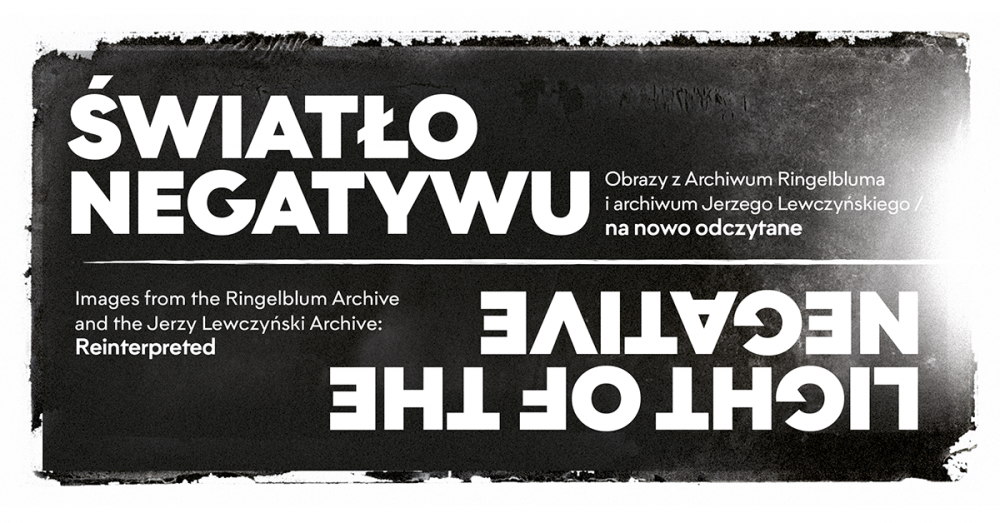- News
- Events
- Oneg Shabbat
- Collections
- Research
- Exhibitions
- Education
- Publishing Department
- Genealogy
- About the Institute
- Bookstore


There is a line which cancels the difference between a negative an a positive. A photograph which is a transfer of past matters had the features of a document of direct participation in the events. In the process of searching for absolute truths, the negative becomes the first and the most reliable witness.
(Jerzy Lewczyński / translated by Olga Drenda)
The Ringelblum Archive, collected by the Oneg Shabbat group, contains — among others – a set of 76 photographs, inside views onto the closed community in the Warsaw Ghetto. After unearthing the first part of the Archive in 1946, researchers gave titles to the photographs and tried to decode locations and people recorded on the images.
After more than 70 years, we return to these images and traces of past events. A suggestion for their new reading – as images and as text, as well as relationships between them – came from Prof. Georges Didi Huberman, lecturer at the École des hautes études en sciences sociales in Paris, one of the most renowned researchers of the theory of the image.
Didi-Huberman asks after Anna Duńczyk-Szulc, co-curator of the exhibition, questions fundamental for the interpretation of the photographs from the Ringelblum Archive. Are these photographs actually a body of a collection? Or are they too diverse to find a coherent theme among them? How should we understand the material incoherence of prints, different in type of paper and technical condition? […] who had actually taken these photographs? How were they collected?
Even though images from the Archive are functioning in „apparent chaos”, Georges Didi-Huberman notices in these remains a precise transfer of three historically and politically articulated paradigms: the rule of tyrants, the rule of the persecuted, the untamed nation – on the basis of which these images can be divided into sets and groups. These constellations provide new possibilities for reading them.
Photographs from the Ringelblum Archive are presented at the exhibition alongside Jerzy Lewczyński’s archive – glass negatives, found in the 1960s at the attic of a house in Sanok. They depict a Jewish family from the early 20th century and were taken by Henryk Eisenbach, a pharmacist.
Jerzy Lewczyński was the author of the concept of archeology of photography – activities aimed at discovering, researching and commenting events, facts, situations which were taking place in „photographic past” (Manifesto, July 1979). His archeological method led through historical search of people presented on the images from the „photographic past” towards creating a new work of art which would reproduce the mythical language of the memory of a negative in an image.
Lewczyński included Eisenbach’s non-professional photographs into his artistic activity and historical search. This work suggests a visual key for reading images from the Ringelblum Archive. In the process of archeology of phorography, the light of the negative, which had sculpted the past common presence in the negative […] is a trace of the „past” light, an authentic witness of past events.
Photographs collected by Oneg Shabbat, thanks to the light of the negative from the images found at the attic in a house in Sanok, regain their great internal power. The images from the Archive receive new conditions of visibility which allows for re-reading them, and for asking the most important question: „Who is a witness?”
The exhibition, based on two Jewish archives, asks questions about the method of reading photography and understanding images which had survived the Holocaust. Does the condition of lacking so much information allow for finding their internal order, can they be treated as a presentation of a specific anthropological and historical method?
Curator, concept author | Rafał Lewandowski
Curator | Anna Duńczyk-Szulc
Introductory essay | prof. Georges Didi-Huberman
Exhibition project | Aneta Faner i Piotr Duma (Fish’n’Sheep)
Cooperation | Jolanta Hercog, Michał Krasicki, Olga Pieńkowska, Violetta Bachur, Marta Wojas, Małgorzata Krzanowska, Wioletta Walewska
Academic cooperation | Maria Ferenc Piotrowska, dr Katarzyna Person, dr Agnieszka Żółkiewska, dr Piotr Kendziorek, prof. Andrzej Żbikowski
Translations | Maria Braunstein, Michał Krasicki, Marcin Wawrzyńczak, Dominika Gajewska
Production | Tomasz Marzec (KONTRA, Pracownia Plastyczna)
Partner: Fundacja Archeologia Fotografii
Organizers | Żydowski Instytut Historyczny im. Emanuela Ringelbluma, Program Oneg Szabat, Stowarzyszenie Żydowski Instytut Historyczny w Polsce
Media patrons | Co Jest Grane24, Radio Kampus, Midrasz, Vogue Polska
Finansed by | The Ministry of Culture and Heritage
----------------------
Monday – Friday: 9:00 am – 6:00 pm, standard ticket: 12 zł
Sunday: 10:00 am – 6:00 pm, free admission
-----------------------
The exhibition is an element of the Oneg Szabat Program implemented by the Emanuel Ringelblum Jewish Historical Institute and the Association of the Jewish Historical Institute of Poland, within a public-private partnership.
